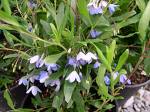Gentian - Best Herb for Digestion | Inflammation
Gentiana lutea Gentianaceae Also called Great yellow gentian, Bitterwort This large, upright perennial is commonly found in the Alps and other mountainous areas south of Europe. Yellow gentian's large leaves have five to seven prominent veins on the underside. The plant's showy flowers are a golden yellow and grow at the points where the leaves meet the stem. The thick, wrinkly roots have a bitter taste. Parts used
ConstituentsThe bitter taste of the yellow gentian root is due to secoiridoids, principally amarogentin and also gentiopicroside (from the Greek pikros, meaning bitter). Whenthey are taken internally these substances provoke a reflex action that stimulates salivary and gastric secretions. Medicinal usesThe substances in yellow gentian stimulate the flow of saliva and gastric juices even in very small amounts. A simple experiment proves it: merely grinding the root will cause one to salivate. The root is traditionally used to remedy a lack of appetite and has long been an ingredient in aperitif drinks. It acts as a tonic on the whole digestive system, relieving gastric pains and improving sluggish digestion. A clinical study published in 1967 verified yellow gentian's digestive qualities, observing that the herb promoted the secretion of gastric juices. Yellow gentian is also reputed to lower fevers and treat inflammation PREPARATION AND DOSAGEFor internal use TO TREAT gastric pains, sluggish digestion, 1055 of appetite INFUSION Add 0.6-2g of dried root to 1 cup of boiling water. Infuse for 10 minutes, then strain. Drink 3 cups a day. DRINKABLE SOLUTIONS, MEDICINAL WINES, SYRUPS Take 1-4 tablespoons before main meals. TINCTURE Take 2-5 drops with water before eating. IF SYMPTOMS PERSIST CONSULT A DOCTOR CultivationPlant in well-drained, humus-rich soil in a sunny or lightly shaded location. CAUTIONS
|
Ayurveda Book
This book on Ayurveda is meant for people interested to know about basics concepts of Ayurvedic healing and learn ayurveda concepts. Though there are many books Read More My SitesReal Testimonials
Connect with us |







